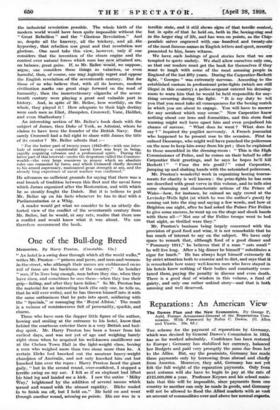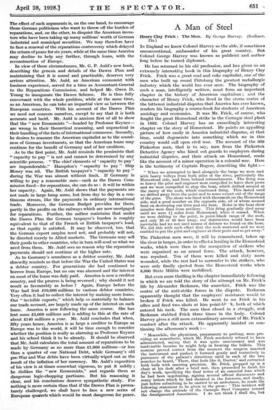Reparations : An American View The Dawes Plan and the
New Economics. By George P. Auld, Former Accountant-General of the Reparations Com- mission. With Foreword by Rufus C. Dawes. (G. Allen and Unwin. 10s. 6d.) Tax scheme for the payment of reparations by Germany, which was devised by General Dawes's -Commission in 1924,
has so far worked admirably. Confidence has been restored to Europe ; Germany has stabilized her currency, balanced her Budgets and paid very promptly the sums due from her to the Allies. Bid, say the pessimists, Germany has made these payments only by borrowing from abroad and chiefly from America. Moreover, they add, Germany has not yet
felt the full weight of the reparation payments. Only from next autumn will she have to begin to pay at the rate of 8125,000,000 a year. Professor Keynes and his school main- tain that this will be impossible, since payments from one country to another can only be made in goods, and Germany will not be allowed to flood the Allied markets with so vast an amount of commodities over and above her normal exports.
The effect of such arguments is, on the one hand, to encourage those German politicians who want to throw off the burden of reparations, and, on the other, to disquiet the American inves- tors who have been taking up many millions' worth of German industrial and municipal securities. We 'may therefore have to face a renewal of the reparations controversy which delayed the return of peace for six years, while at the same time America may decline to help any further, through loans, with the reconstruction of Europe.
In view of these circumstances, Mr. G. P. Auld's new book, describing the genesis and details of the Dawes Plan and maintaining that it is sound and practicable, deserves very serious attention. Mr. Auld, an American economist with business experience, served for a time as Accountant-General to the Reparations Commission, and helped Mr. Owen D. Young to inaugurate the Dawes Scheme. He is thus fully conversant with the whole problem, while at the same time, as an American, he can take an impartial view as between the European countries. With his account of the Dawes Plan we need not concern ourselves, except to say that it is both accurate and lucid. Mr. Auld is anxious first of all to show that the " new Economists "—headed by Professor Keynes— are wrong in their theoretical reasoning, and unpractical in their handling of the facts of international commerce. Secondly, he desires to reassure the American capitalist as to the sound- ness of German investments, so that the American loans may continue for the benefit of Germany and of her creditors.
As to the first point, Mr. Auld reminds the pessimists that " capacity to pay " is not and cannot be determined by any scientific process. " The chief elements of ' capacity to pay' are imponderable." Hampden's " capacity to pay " Ship Money was nil. The British taxpayer's " capacity to pay " during the War was almost without limit. If Germany is willing to pay a reasonable sum—such as the Dawes Com- mission fixed—for reparations, she can do so : it will be within her capacity. Again, Mr. Auld shows that the payments are not made in large lump sums, but from day to day in a con- tinuous stream, like the payments in ordinary international trade. Moreover, the German Budget provides for them, partly in the profits on the railways which are now mortgaged for reparations. Further, the author maintains that under the Dawes Plan the German taxpayer's burden is roughly equivalent to that of the French or British taxpayer's load, so that equity is satisfied. It may be observed, too, that the German export surplus need not, and probably will not, be directed merely to Allied markets. The Germans may sell their goods to other countries, who in turn will send us what we need from them. Mr. Auld sees no reason why the reparation payments should not continue at the higher rate.
As to Germany's soundness as a debtor country, Mr. Auld shrewdly reminds us that before the War the United States was a debtor country. For generations she had continued to borrow from Europe, but no one was alarmed and the interest on most of the loans was duly paid. America is now a creditor country, and the process is being reversed ; why should it not result as favourably as before ? Again, Europe before the War had lent £10,000 millions to various debtor countries. Very often it had to collect the interest by making more loans. Our " invisible exports," which help so materially to balance our trade account, are largely made up of the interest on such loans. America is now following the same course. She has lent some £8,000 millions and is adding to this at the rate of about £140 millions a year. Mr. Auld concludes that when, fifty years hence, America is as large a creditor to Europe as Europe was to the world, it will be time enough to consider whether the position is really as alarming as Professor Keynes and his school think it to be already. It should be observed that Mr. Auld calculates the total amount of reparations to be made by Germany as no more than £1,900 millions—or less than a quarter of our National Debt, while Germany's old pre-War and War debts have been virtually wiped out as the result of the inflation of her currency. Mr. Auld's exposition of his view is at times somewhat vigorous, to put it mildly ; be dislikes the " new Economists," and regards them as dangerous logic-chopping partisans. But his reasoning is clear, and his conclusions deserve sympathetic study. For nothing is more certain than that if the Dawes Plan is prema- turely challenged, we shall have to face a new series of European quarrels which would be most dangerous for peace.







































 Previous page
Previous page